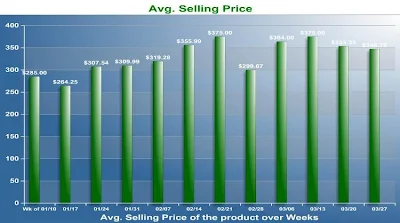-
Unlike computers, Amateur radios are not considered obsolete every year or so. Computers get faster, and as the get faster, the Software gets fatter, so in would be very painful (if not impossible) to run XP on a PC made ten years ago - and even if you could, it would be so slow you would not be able to use it for what it was intended for.
Radios on the other hand have had the same objective year after year - to contact another person a mile away or thousands of miles away, through the airwaves. So I can take a radio over 50 years old and either talk or use Morse Code to someone just as well as one of the latest rigs off the shelf.
-

Take a look at the chart above. This is for the Kenwood TS-520, which is mostly solid-state with tube finals (70's era). The price is consistently in the $200 range and would make a nice starter rig. It is Ham band only (no general coverage receiver), but has great audio and is resistant to a higher SWR, one that would shutdown a solid-state rig.

=
Now the 101 never had a built-in digital readout, but they did offer the YC-601 external readout with big red digits. This was one of my first ham rigs, so I guess I always come back it from now and then......I guess throughout the years I've bought and sold at least a couple dozen.
 The chart above is for the ICOM IC-730, which is all solid-state and sells in the mid-$200 range. BTW, before I go any further, you can always check on the reliability of this rigs by going to EHAM-REVIEWS which is filled with the opinions of your fellow Amateur Radio Operators. Unlike the Hybrid rigs like the 520 and 101, most solid-state rigs run on 12vdc and require an external power supply, so if you don't happen to have a 12v 20-25amp power supply laying around, you'll have to add that cost to your setup. You can find the ICOM matching power supply, or buy one from another vendor. Usually if you buy one, for instance a Kenwood PS-30 it's plug will fit and work on the Yaesu as well. I believe the same is true for ICOM, but never having done it before, I'm not going to say it will.
The chart above is for the ICOM IC-730, which is all solid-state and sells in the mid-$200 range. BTW, before I go any further, you can always check on the reliability of this rigs by going to EHAM-REVIEWS which is filled with the opinions of your fellow Amateur Radio Operators. Unlike the Hybrid rigs like the 520 and 101, most solid-state rigs run on 12vdc and require an external power supply, so if you don't happen to have a 12v 20-25amp power supply laying around, you'll have to add that cost to your setup. You can find the ICOM matching power supply, or buy one from another vendor. Usually if you buy one, for instance a Kenwood PS-30 it's plug will fit and work on the Yaesu as well. I believe the same is true for ICOM, but never having done it before, I'm not going to say it will.
Getting a bit pricier, the ICOM IC-735, but the receiver is sharper and it is newer than the IC-730.(Usually,NEWer = More $$$)


=
 TS-430
TS-430
FT-757GX
I'm skipping through the years, and there are many other models you could pick, but I had to mention Kenwood's TS-430 and the Yaesu FT-757GX which were breakaway hits because they were a lot smaller compared to a 520 or 101, yet not only did they have the HAM bands, they also had "General Coverage" receivers, for shortwave buffs, and other groups, including some on the 11m band, because by moving a switch or clipping a diode gave you General Coverage TRANSMIT as well. A no-no to do, none-the-less it was done to many rigs.-
If you made a graph starting from the 50's to 2000, you'd find it looking like a "U", because the oldest rigs are now "Collectors" items (thus pricey) and the newer rigs are somewhat expensive as well. A good example of an older rig being pricey is Heathkit (pick a model, any model) and it can get out of your price range and quite a few others. My first HAM Rig was a Heathkit HW-5400 with matching PS/Spkr and regret selling it because whenever they come up for auction on EBAY, the price expensive!
-
With a little electronic knowledge behind you, it's possible to build your own rig. It may not be pretty, or have all the bands, but you'll learn things via mistakes, come to appreciate what you've done, and after you make your first QSO on it - pat yourself on the back!!
-
So there you have it......something to think about
-
No comments:
Post a Comment